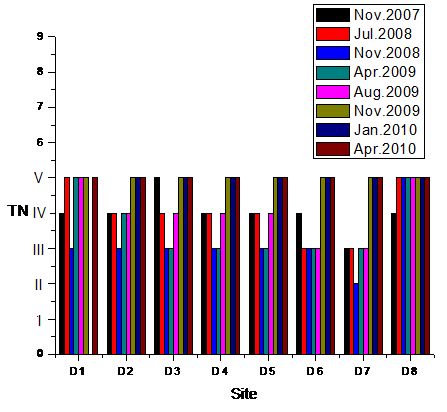Water Quality Evaluated Using Integrated Assessment Based on Multistep Correlation Analysis in Danjiangkou Reservoir
2015-07-24
Freshwater ecosystems provide the essential water needs for humans, support recreation and transportation, and supply electricity and food via fishing and farming. However, many lakes, reservoirs, streams and rivers have been facing declining water quality, which threatens human water security and biodiversity worldwide, particularly in developing countries.
The Danjiangkou Reservoir is the water source for China’s south-to-North Water Transfer Project (Middle Route), which diverting water to the North China Plain for irrigation, industrial and domestic usages. Therefore, water quality in the Reservoir is crucial for public health and economic development in the reception area.
Prof. ZHANG Quanfa and associate Prof. TAN Xiang from Wuhan Botanical Garden investigated the spatial pattern and temporal dynamics of 13 water quality variables in nutrient, heavy metal and trace elements in 8 sites with 2 replicates during 2007-2010. Then, this research team evaluated the water quality grade using multistep correlation analysis based on grey theory.
There were great temporal dynamic in water quality in the extensive Danjiangkou Reservoir from 2007 to 2010. The concentrations of TN (total nitrogen), NH4+-N (ammonium-nitrogen), Cr (chromium) and Pb (lead) showed a trend of increasing. The concentrations of most sampled heavy metals and trace elements except As(arsenic) in the dry season were much higher than those in the wet season. The major pollutants were TN, As, and Pb. The concentration of As exceeded the maximum allowable contamination level of USEPA (U.S. Environmental Protection Agency) and Pb was 20 times higher than the standards of WHO. Therefore, great efforts should be made to reduce nitrogen, As and Pb pollution for water conservation in the Reservoir.
Based on the WHO and China’s national standards (WHO, 2011; GB3838-2002, Ministry of Environmental Protection, 2002), water quality in the sampling site could be graded from grade Ⅰto Ⅴ. Integrated evaluation based on multistep correlation analysis using all 13 variables simultaneously provided a simplified and overall water quality assessment showing that water quality deteriorated from grade Ⅰ and Ⅱ in 2007 to Ⅱ and Ⅲ in 2010.
In this study, the multistep correlation analysis based on grey theory in water quality assessment was confirmed that it can provide systematic and comprehensive assessment of water quality.
This research was published in Journal of Environmental Informatics entitled “Water Quality Characteristics and Integrated Assessment Based on Multistep Correlation Analysis in the Danjiangkou Reservoir, China”. It was funded by the National NaturalScience Foundation of Chinaand the National Key Technology R & D Program.

Water quality assessment using individual variable (total nitrogen, TN) by the China’s Environmental Quality Standards in SurfaceWater (GB3838-2002) from 2007-2010 (Image by XiangTAN)